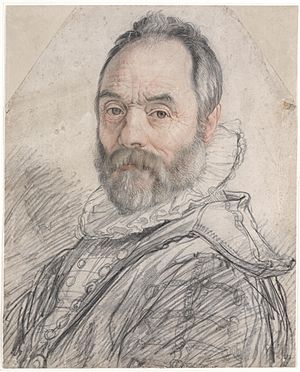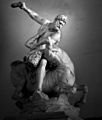Giambologna facts for kids

Giambologna (born 1529, died 1608) was a very important sculptor from the Italian Renaissance. His real name was Jean de Boulogne, but he was known by many names like Giovanni da Bologna. He had a big workshop where he created many amazing sculptures. These works were made from bronze and marble. His art style is called late Mannerism.
Contents
Giambologna's Early Life
Giambologna was born in 1529 in a place called Douai. This area was then part of Flanders, which is now in France. When he was young, he studied art in Antwerp. His teacher was an architect and sculptor named Jacques du Broeucq.
In 1550, Giambologna moved to Italy. He went to Rome to study old Roman and Greek sculptures. He also learned a lot from the famous artist Michelangelo. But Giambologna created his own special art style. It was called Mannerism. His style focused on smooth surfaces, elegant shapes, and beauty.
Life in Florence
Giambologna spent most of his working life in Florence, Italy. He moved there in 1553. In 1563, he became a member of a famous art school. It was called the Accademia delle Arti del Disegno. This school was started by Duke Cosimo I de' Medici.
Giambologna became one of the most important sculptors for the Medici family. They were very powerful rulers in Florence. His first big job was for Pope Pius IV. He made a huge bronze statue of Neptune. This statue was for the Fountain of Neptune in Bologna.
Giambologna died in Florence when he was 79 years old. The Medici family never let him leave Florence. They were afraid that other powerful families, like the Habsburgs, would hire him. He was buried in a chapel in Florence that he designed himself.
Famous Sculptures and Art Style
Giambologna was known for making sculptures that showed lots of action and movement. His works also had very smooth and detailed surfaces.
Notable Works
One of his most famous sculptures is of the god Mercury. He made four versions of this statue. Mercury is shown balancing on one foot, as if flying. He points one arm towards the sky. This pose was a common way to show movement in art.
Another famous work is Abduction of a Sabine Woman. This large marble sculpture is in Florence. It shows three people carved from a single piece of marble. Giambologna actually carved it without a specific story in mind. The name was given to it later.
He also created Hercules Slaying a Centaur. This marble statue was placed in Florence in 1599. Giambologna made many statues of Venus, the goddess of love. These statues helped set the standard for how female figures were shown in art. Many sculptors after him used his Venus statues as models.
Political Art
Giambologna also made sculptures that supported the Medici family's power. One example is Florence Triumphant over Pisa. This sculpture showed Florence winning over its rival city, Pisa.
Another important marble work is Samson Slaying a Philistine. This sculpture was made for a Medici fountain. It shows a violent scene from all sides. This is the only large marble sculpture by Giambologna that has left Florence. It is now in the Victoria and Albert Museum in London.
Other Contributions
Giambologna also made many sculptures for gardens and fountains. These include works for the Boboli Gardens and Pratolino in Florence. He also created bronze doors for the cathedral of Pisa. He sculpted bronze sea-horses for the Fountain of Neptune in Florence.
He made a series of animal studies from real life. These can be seen today at the Bargello museum. Smaller bronze copies of his sculptures were very popular. People admired his work then and still do today.
Giambologna's Influence
Giambologna had a big impact on other sculptors. His students, like Adriaen de Vries and Pietro Francavilla, carried his style to other parts of Europe. Pietro Tacca took over Giambologna's workshop in Florence. Famous sculptors like Gian Lorenzo Bernini and Alessandro Algardi in Rome were also influenced by his work.
Gallery
-
Samson Slaying a Philistine, about 1562, V&A Museum London
-
Hercules and Nessus, 1599, Loggia dei Lanzi, Florence
-
Bathing Venus, 1573, Buontalenti Grotto, Boboli Gardens, Florence
See also
 In Spanish: Juan de Bolonia para niños
In Spanish: Juan de Bolonia para niños






